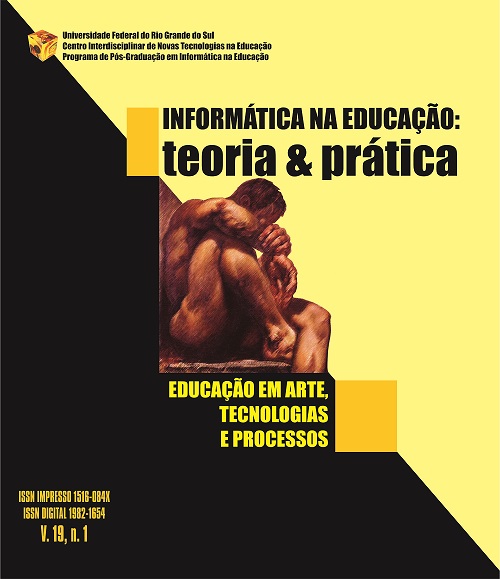Games, Pedagogy and Art Education
DOI:
https://doi.org/10.22456/1982-1654.57830Abstract
In 1848, under the auspices of the Smithsonian Institution, Squier and Davis documented what is now referred to as the Newark Earthworks, Ohio (USA). Built over two thousand years ago by indigenous peoples, understanding the earthworks has been ongoing. The Octagon Earthwork in Newark, Ohio was named one of the seventy wonders of the ancient world (Scarre, 1999), and yet this American Indian spiritual space is occupied by a private country club whose golf course winds around the mound. This article provides an introduction to earthworks, the approach to designing interactive curricula, including games and a pedagogy of educational games, which can virtually bring an important site such as the Octagon Earthwork into the classroom.Downloads
References
Aubrecht, M. and Ballengee-Morris, C. (2013). “Game changing: Developing meet the
earthworks builders.” In Y. Baek (Ed) Psychology of Gaming. New York: Nova
Blosser, J. Personal presentation on June 19, 2014, Fort Ancient, Ohio.
Congdon, K., Blandy, D., & Bolin, P. (2000). Histories of community-based art
education. Reston, VA: National Art Education Association.
Daniel, V. (2001). Art education as a community act: Teaching and learning through the
community. Conference Proceedings for the New prospects of Art Education in
Theory and Practice Symposium, National Taiwan Normal University, Taipei.
Deloria, V. (1969). Custer died for your sins; an Indian manifesto. New York:
Gee, J.P. (2008). Learning and games. In Salen, Katie (Ed.) The ecology of games:
Connecting youth, games, and learning. The John D. and Catherine T. MacArthur
Foundation Series on Digital Media and Learning. Cambridge, MA: The MIT Press.
Gee, J. P. (2007). What video games have to teach us about learning and literacy (1st
ed.). New York: Palgrave Macmillan.
Gee, J. P. & Hayes, E. (2011). Language and learning in the digital age. New York:
Gerdes, K. E., Segal, E. A., Jackson, K. F., & Mullins, J. L. (2011). Teaching empathy: a
framework rooted in social cognitive neuroscience and social justice. Journal of
Social Work Education, 47(1), 109-131.
Hively, R. & Horn, R. (1982). Geometry and astronomy in prehistoric Ohio.
Archaeoastronomy (Supplement to Vol. 13, Journal for the History of Astronomy)
Huang, R, & Tettegah, S. (2010). A conceptual framework to understand the relationship
between Cognitive load and empathy development in serious games. In Richard
Van Eck’s (Ed). In gaming and cognition: Theories and perspectives from the
learning sciences. Hershey, PA: IGI Global.
Jenkins, H. (2006). Convergence culture: Where old and new media collide. New York:
Kilpatrick, J. (1999). Celluloid Indians. Lincoln, NE: University of Nebraska.
Lepper, B. T. (1996). The Newark Earthworks and the Geometrical Enclosures of the
Scioto Valley: Connections and Conjectures. In Pacheco, P. (Ed). A View from the
Core: A Synthesis of Ohio Hopewell Archaeology. Columbus, OH: Ohio
Archaeological Council. (p. 225-241).
Leuthold, S. (1998). Indigenous aesthetics: Native art and identity. Austin, TX:
Mcneilly, J. (2008, November 24). The top 7…Native American stereotypes. Retrieved
November 20, 2011: http://www.gamesradar.com/the-top-7-native-american-
Prensky, M. (2010). Teaching digital natives: Partnering for real learning. London:
Scarre, C. (1999). The Seventy Wonders of the Ancient World. London: Thames &
Sharp, G. (2011, August 9). Stereotypes of Native Americans in video games.
Sociological Images. Retrieved November 20, 2011:
http://thesocietypages.org/socimages/2011/08/09/stereotypes-of-native-
Smith Tuhiwai, L. (2005). Decolonizing methodologies: Research and Indigenous
peoples. London: Zed Books, Ltd.
Squire, K. (2011). Video games and learning: Teaching and participatory culture in the
digital age. NYC: Teachers College Press.
Squier, E. & Davis, E. H. (1998). Ancient monuments of the Mississippi valley. In
Smithsonian Contributions to Knowledge . Washington D.C.: Smithsonian
Institution (Original work published 1848).
Taylor, P. G., & Ballengee Morris, C. (2004). Service-Learning A language of “we.” Art
Taylor, P. G., Ballengee Morris, C., & Carpenter, B. S. (2010). Digital visual culture,
social networking, and virtual worlds: Second Life and art education. In Robert
Sweeny (Ed.), Digital Visual Culture: Interactions and Intersections in 21st
Century Art Education. Reston, VA: National Art Education Association.
Thomas, D. H., Miller, J., White, R., Nabokow, P.,& Deloria, P.(1993). The Native
American. Atlanta, GA: Turner Publishing, Inc.
Downloads
Published
How to Cite
Issue
Section
License
The copyright for papers published in this journal belong to the author, with rights of first publication for the journal. As the papers appears in this publicly accessed journal, the papers are for free use, receiving their credit, in educational and non-commercial uses. The journal will allow the use of the papers published for non-commercial purposes, including the right to send the paper to publicly accessed databases.Accepted 2016-03-01
Published 2016-06-02


